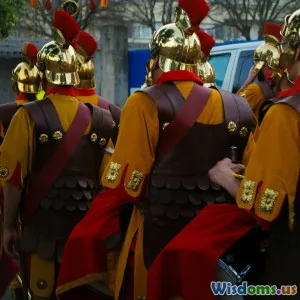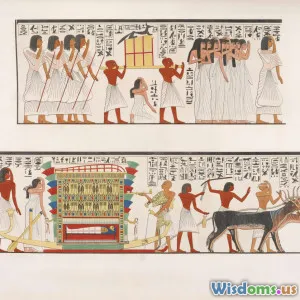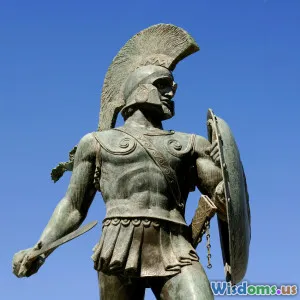
Did Chariots Win More Battles Than Infantry
8 min read Exploring whether chariots outperformed infantry in ancient battles based on historical evidence and military strategy. (0 Reviews)
Did Chariots Win More Battles Than Infantry?
Warfare in the ancient world showcased a variety of military innovations that shaped the outcomes of countless conflicts. Among these innovations, the war chariot stands out as an iconic and dramatic example of early military technology. But did chariots truly win more battles than infantry forces, or is this simply a myth amplified by cinematic depictions? In this article, we dissect the evidence — from historical records, archaeological findings, to battle tactics — to provide a comprehensive answer to this age-old question.
Introduction: The Historical Context of Chariots and Infantry
Chariots emerged during the Bronze Age as a revolutionary form of battlefield mobility and force projection. By combining horses, wheels, and warriors, militaries could rapidly engage enemies and exploit the battlefield's dynamics. Infantry, on the other hand, numbers of foot soldiers armed with spears, swords, and shields, have been the backbone of armies since prehistory.
At first glance, the chariot might seem like the superior war machine: faster, more mobile, and imposing. Yet infantry survived and thrived for millennia, even after the decline of chariots. Understanding whether chariots won more battles than infantry means exploring not just tactical effectiveness, but logistical constraints, evolving warfare methods, and shifting military doctrines.
The Rise of the Chariot in Warfare
Origins and Military Innovations
Chariots originated around 2000 BCE, with some of the earliest evidence in Mesopotamia and the Eurasian Steppes. The mobility offered by combining horses and wheel-based vehicles transformed warfare by allowing rapid flanking, quick archery deployment, and shock attacks.
The Hyksos invasion of Egypt around 1650 BCE spotlighted chariots as decisive military units, later adapted extensively by Egyptian armies under rulers such as Thutmose III. Meanwhile, the Hittites developed heavier chariots carrying multiple warriors, enhancing their battlefield roles.
Tactical Advantages of Chariots
- Speed and Maneuverability: Chariots enabled armies to perform quick flanking maneuvers, disrupting infantry formations.
- Platform for Archery: Archers on chariots could shoot with greater advantage, firing from a moving platform.
- Psychological Impact: The noise, dust, and speed of chariots often intimidated opposing infantry.
For instance, in the Battle of Kadesh (circa 1274 BCE), the Egyptian and Hittite armies showcased extensive chariot use, underlining their central role in military doctrine of the era.
The Dominance of Infantry: Breadth and Depth of Combat
The Versatility and Resilience of Foot Soldiers
Despite the advantages of chariots, infantry remained dominant in most battles because:
- Terrain Flexibility: Infantry could operate across rugged or forested terrain inaccessible to chariots.
- Numbers and Sustainability: Armies could field many infantrymen; chariots were expensive and required trained horses.
- Close-Quarter Combat: Infantry excelled in hand-to-hand combat where chariots were less effective.
Pivotal Battles Highlighting Infantry Superiority
One infamous example is the Battle of Gaugamela (331 BCE), where Alexander the Great’s infantry phalanx played a decisive role despite facing chariot and cavalry threats. Similarly, Assyrian infantry innovations incorporated massed spearmen and heavily armored troops that neutralized chariot charges.
Archaeological and Historical Evidence
Chariot Remains and Battle Sites
Sites like the ancient city of Megiddo have yielded chariot artifacts that confirm their use but suggest limited deployment compared to infantry mass.
Written Records and Chroniclers
Classical historians such as Herodotus and later Polybius ascribe decisive roles to infantry formations like the Greek hoplites and Roman legions, even when chariots or mounted units were present on battlefields.
The Decline of Chariot Warfare
From the Iron Age onwards, chariots gradually fell out of favor, replaced by cavalry which combined mobility and combat flexibility without the cumbersome limitations of wheels and horses.
This transition underscores a crucial insight: infantry’s adaptability outlasted chariot technology, highlighting that infantry victories were more frequent over the long timeline.
Tactical Limitations of Chariots Compared to Infantry
Despite their formidable appearance, chariots had clear limitations:
- Terrain Dependency: Chariots required flat terrain; uneven ground rendered them less effective.
- Logistical Costs: Feeding and maintaining horse teams and chariot supplies was resource-intensive.
- Vulnerability: Chariots were vulnerable to archers, spikes, caltrops, and tight infantry formations.
Conversely, infantry formations using pikes, spears, or shields had tactics expressly to counter chariot assaults.
Modern Understandings from Experimental Archaeology
Reenactments and archaeologically informed simulations provide modern insights:
- Projects recreating chariot charges suggest shock impact is limited against disciplined infantry holding formation.
- Infantry tight formations like the Greek phalanx minimized chariot effectiveness.
Such experimental findings underscore that chariots were tactical force multipliers rather than outright battle-winners.
Conclusion: Who Won More Battles — Chariots or Infantry?
While chariots revolutionized ancient warfare upon their introduction and won critical early battles, infantry forces ultimately won more battles across recorded history. Infantry’s superior adaptability, sustainability, and tactical versatility ensured their role as the primary decisive fighting force in warfare.
Chariots served as effective complements to infantry and cavalry but rarely formed the core winning component of armies. Their legacy is indisputably important as a technology and cultural symbol of ancient military innovation, but the infantry's gritty resilience and strategic depth held sway for millennia.
For students of military history and enthusiasts alike, understanding this dynamic equips us with a richer appreciation for how warfare evolved and unveils why battlefield success depends on far more than a single technological novelty.
References:
- Herodotus, Histories
- Battle analyses from the Cambridge Ancient History
- Archaeological reports from Megiddo and Kadesh excavations
- Experimental archaeology accounts from the University of Edinburgh
Explore the juncture where technology meets human valor to uncover the real champions of ancient combat.
Rate the Post
User Reviews
Popular Posts

















